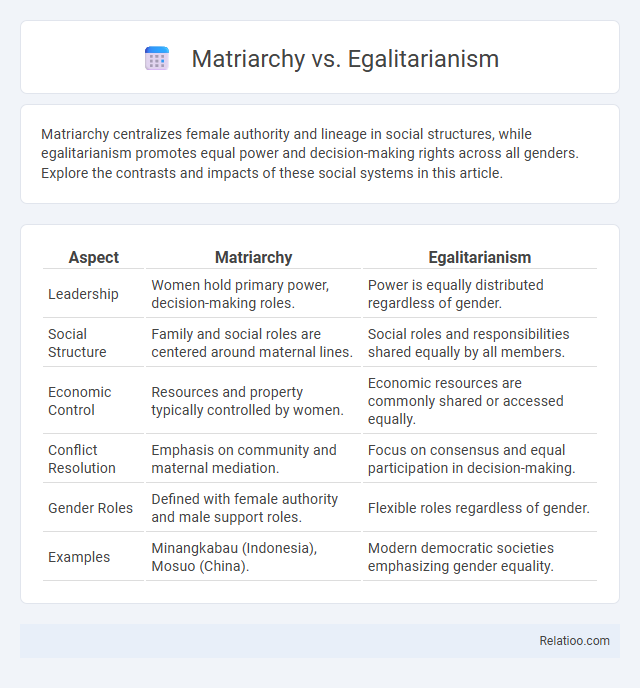Matriarchy centralizes female authority and lineage in social structures, while egalitarianism promotes equal power and decision-making rights across all genders. Explore the contrasts and impacts of these social systems in this article.
Table of Comparison
| Aspect | Matriarchy | Egalitarianism |
|---|---|---|
| Leadership | Women hold primary power, decision-making roles. | Power is equally distributed regardless of gender. |
| Social Structure | Family and social roles are centered around maternal lines. | Social roles and responsibilities shared equally by all members. |
| Economic Control | Resources and property typically controlled by women. | Economic resources are commonly shared or accessed equally. |
| Conflict Resolution | Emphasis on community and maternal mediation. | Focus on consensus and equal participation in decision-making. |
| Gender Roles | Defined with female authority and male support roles. | Flexible roles regardless of gender. |
| Examples | Minangkabau (Indonesia), Mosuo (China). | Modern democratic societies emphasizing gender equality. |
Understanding Matriarchy: Definitions and Origins
Matriarchy refers to social systems where women hold primary power positions in roles of political leadership, moral authority, and control over property. Its origins trace back to ancient societies where kinship and inheritance were traced through the female line, often linked to agrarian communities prioritizing maternal lineage. Understanding matriarchy involves examining anthropological evidence and cultural practices that contrast with egalitarian systems, which emphasize equal power distribution regardless of gender.
Egalitarianism Explained: Principles and Goals
Egalitarianism advocates for equal rights, responsibilities, and opportunities regardless of gender, aiming to eliminate social hierarchies and promote fairness across all aspects of life. Your understanding of egalitarian principles highlights its commitment to inclusivity, where power and resources are shared equitably among individuals. This contrasts sharply with matriarchy and patriarchy, which concentrate authority based on gender, whereas egalitarianism seeks a balanced and just society for all.
Historical Contexts: Societies Under Matriarchy
Societies under matriarchy historically emphasize women's leadership in social, economic, and political spheres, often linked to kinship traced through the maternal line. Examples include the Iroquois Confederacy, where clan mothers held significant authority in decision-making and governance. These matriarchal systems contrast with egalitarian societies, which promote equal power dynamics regardless of gender, reflecting different historical developments in social organization and cultural values.
Egalitarian Societies: Key Examples and Features
Egalitarian societies prioritize equal access to resources, decision-making, and social status regardless of gender, contrasting sharply with matriarchal and patriarchal systems where power dynamics favor one gender. Key examples include certain Indigenous groups such as the Hadza of Tanzania and the San people of Southern Africa, who emphasize communal sharing, consensus-based governance, and gender parity in leadership roles. These societies feature flexible gender roles, minimal social hierarchies, and collective responsibility, fostering social cohesion and equality.
Gender Roles: Contrasts Between Matriarchy and Egalitarianism
Gender roles in matriarchal societies often emphasize female leadership, property inheritance through the maternal line, and nurturing roles assigned to women, establishing clear societal structures based on gender. Egalitarian systems promote gender equality by minimizing traditional roles and encouraging shared responsibilities across all genders, fostering balanced power dynamics and opportunities. Your understanding of these contrasts highlights how matriarchy reinforces gender-specific roles, whereas egalitarianism seeks to dissolve them for equitable participation.
Impact on Social Structures and Power Dynamics
Matriarchy establishes social structures where women hold primary power in roles of political leadership, moral authority, and control over property, often leading to matrilineal inheritance and community organization. Egalitarianism promotes equal distribution of power and resources, minimizing hierarchical distinctions and fostering cooperative decision-making processes within societies. Patriarchy concentrates authority in male-dominated hierarchies, shaping legal systems and cultural norms that prioritize male leadership and influence over economic and social institutions.
Economic Systems: Resource Distribution and Gender
Matriarchy emphasizes female leadership in resource control, often resulting in economic systems where wealth and power flow predominantly through women, shaping social and familial roles around maternal authority. Egalitarianism promotes balanced resource distribution regardless of gender, fostering economic systems designed to ensure equal access, opportunities, and responsibilities for everyone in the community. Understanding your position within these frameworks helps illuminate how gender influences economic power and resource allocation across diverse societies.
Family and Community Organization in Both Models
Matriarchy organizes family and community roles around female leadership, emphasizing maternal authority and communal decision-making rooted in lineage through women, while egalitarianism promotes equal participation and shared responsibilities regardless of gender, fostering inclusivity and balanced power dynamics in family and community structures. You benefit from understanding how matriarchal systems prioritize kinship and heritage, contrasting with egalitarian models that eliminate hierarchical gender divisions to create cooperative and flexible social frameworks. These organizational differences impact inheritance, child-rearing, and social support networks, shaping diverse cultural approaches to family cohesion and community collaboration.
Modern Movements: Calls for Matriarchy or Egalitarianism
Modern movements advocating for matriarchy emphasize the restoration of women-centered social structures, highlighting historical examples like the Iroquois Confederacy to challenge patriarchal dominance. Egalitarianism movements prioritize gender equality and the dismantling of systemic biases, promoting inclusive policies and equal representation in political and economic spheres. Both movements critically engage with patriarchal frameworks, yet matriarchal activism calls for societal redress through female leadership, while egalitarianism seeks balanced power distribution across all genders.
Challenges and Critiques: Towards a Balanced Future
Matriarchy faces critiques for potential power imbalances favoring women, while egalitarianism struggles with practical enforcement of absolute equality across diverse societies. Both systems encounter challenges in addressing deep-rooted cultural norms and social hierarchies that resist change. Your pursuit of a balanced future requires integrating the strengths of matriarchy's nurturing governance and egalitarianism's commitment to fairness to overcome these limitations effectively.

Infographic: Matriarchy vs Egalitarianism
 relatioo.com
relatioo.com